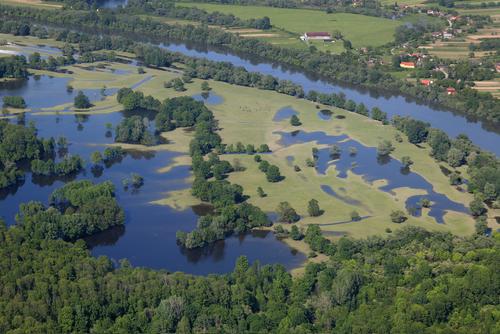
Sava's natural floodplains at Lonjsko Polje Nature Park.
© Goran SafarekNew infrastructure plans will increase flood risk
Joint press release by EuroNatur, Riverwatch and the Croatian Society for Birds and Nature Protection, 22 September 2014
Zagreb, Vienna, Radolfzell. While the worst part of the recent floods in the Sava basin seem to be over, it is crucial to analyse their drivers and consider the lessons to be learned.
Four facts need to be highlighted in connection with the Sava flood:
- Natural floodplains along Central Posavina have reduced the floods further downstream. These floodplains saved lives and property. This area has the potential to store more than 2 billion m3 of water.
- A substantial part of the flood was human-induced. Too many stretches along the river are channelized or dammed and the retention areas are simply too narrow for naturally occurring floods. About 78% of the former floodplains along the whole Sava are disconnected from the river by dykes and dams.
- The cooperation and the information transfer between the four Sava countries in regards to flood prevention is not working effectively.
- Spatial planning constitutes another problem: Too many buildings are located within the floodplains.
“The main lesson learned is that the old flood protection concept, which relies on channelization, dams and reservoirs, is wrong and may even be deadly sometimes. We have to work with nature rather than against it in order to mitigate the flood risk”, says Tibor Mikuška from the “Croatian Society for Birds and Nature Protection”, who is leading the campaign “Save the Blue Heart of Europe” along the Sava.
Nevertheless, decision makers along the river seem to hang on to out-dated concepts. About 19 new hydro-dams are projected or under construction in Slovenia and Croatia (https://www.balkanrivers.net/en/map). Furthermore, the river is threatened by new regulation plans: old fashion navigation schemes foresee an upgrade of the Sava River’s navigation class from Belgrade up to Sisak.
“If these projects become reality, the flood risk will increase substantially. It will not only lead to an ecological catastrophe, but also to a humanitarian disaster”, so Tibor Mikuška.
The flood mitigation concept of the future
A modern flood mitigation system must be based on:
- Preservation of the existing river ecosystem, including its floodplains
- Restoration of historical floodplains wherever possible. According to a WWF study (2010) more than 40,000 to 50,000 hectares could be realistically restored along the entire Sava River. By re-connecting historical floodplains the Sava could become the most exceptional natural flood prevention system in Europe.
- Improvement of spatial planning procedures in order to meet higher standards. No construction of infrastructure should be granted within the area flooded with a 100 years probability.
The Sava River and the Sava campaign
The Sava River represents one of Europe´s ecologically and culturally most interesting lifelines. Along its total length of 944 km the Sava River connects four countries and more than 8 million people.
The Sava is one of three key areas in the international campaign “Save the Blue Heart of Europe”, which aims to save the ecologically most valuable rivers on the Balkan Peninsula. More than 570 hydro dams are projected within the river network between Slovenia and Albania, threatening the best preserved rivers of Europe and their amazing biodiversity. In order to counteract this spate of destruction, EuroNatur and RiverWatch have launched the “Save the Blue Heart of Europe” campaign in cooperation with local partner in the respective Balkan counties. The partner along the Sava is the Croatian Society for Birds and Nature Protection.
For further inquiry contact:
• CSBNP: Tibur Mikuška, Tel: +385 95 909 87 53, tibor.kopacki.rit@gmail.com
• EuroNatur: contact person: Romy Durst, media contact: Angie Rother
Tel: +49 7732 92 72 24, info@euronatur.org
• Riverwatch: Cornelia Wieser, +43 650 4544784, cornelia.wieser@riverwatch.eu


